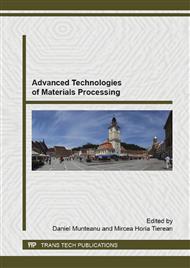[1]
K.K. Alaneme, M.O. Bodunrin, Corrosion behavior of alumina reinforced aluminium (6063) metal matrix composites, Journal of Minerals & Materials Characterization & Engineering 10 (2011) 1153-1165.
DOI: 10.4236/jmmce.2011.1012088
Google Scholar
[2]
A. Sangghaleh, M. Halali, An investigation on the wetting of polycrystalline alumina by aluminium, Journal of Materials Processing Technology 2 (2008) 156-160.
DOI: 10.1016/j.jmatprotec.2007.06.024
Google Scholar
[3]
P. Shen, H. Fujii, T. Matsumoto, K. Nogi, Critical factors affecting the wettability of α-alumina by molten aluminium, Journal of the American Ceramic Society 87 (2008) 2151-2159.
DOI: 10.1111/j.1151-2916.2004.tb06376.x
Google Scholar
[4]
S. Bao, K. Tang, A. Kvithyld, T. Engh, M. Tangstad, Wetting of pure aluminium on graphite, SiC and Al2O3 in aluminium filtration, Transaction of Nonferrous Metal Society of China 2 (2012) 1930-(1938).
DOI: 10.1016/s1003-6326(11)61410-6
Google Scholar
[5]
S. Srinivasan, G.H. McKinley, R.E. Cohen, Assessing the accuracy of contact angle measurements for sessile drops on liquid-repellent surfaces, Journal Langmuir 27 (2011) 13582-13589.
DOI: 10.1021/la2031208
Google Scholar
[6]
J.A. Champion, B.J. Keene, J.M. Sillwood, Wetting of aluminium oxide by molten aluminium and other metals, Journal of Materials Science 4 (1969) 39-49.
DOI: 10.1007/bf00555046
Google Scholar
[7]
M. Ksiazek, N. Sobezak, B. Mikulowski, W. Radziwill, I. Surowiak, Wetting and bonding strength in Al/Al2O3 system, Materials Science and Engineering 3 (2002) 162-167.
DOI: 10.1016/s0921-5093(01)01305-3
Google Scholar
[8]
N. Sobzack, M. Asthana, W. Ksiazek, W. Radziwill, B. Mikulowski, The Effect of Temperature, Matrix Alloying and Substrate Coatings on Wettability and Shear Strength of Al/Al2O3 Couples. Metallurgical and Materials Transactions A 35A (2004).
DOI: 10.1007/s11661-004-0016-9
Google Scholar
[9]
D.A. Weirauch, W.J. Krafick, The effect of carbon on wetting of aluminium oxide by aluminium, Metallurgical Transactions A 21A (1990) 1745-1751.
DOI: 10.1007/bf02672591
Google Scholar
[10]
I. Sulima, B. Mikulowski, Influence of Silicon on the Wetting-Bond Strength-Structure Relationship in the AlSi11/Al2O3 Joints, Metallurgical and Materials Transactions A 37A (2006) 3275-3281.
DOI: 10.1007/bf02586162
Google Scholar
[11]
J.A. Champion, B.K. Keene, J.M. Sillwood, Wetting of Aluminum Oxide by Molten Aluminium and Other Metals. Journal of Materials Science 4 (1969) 39-49.
DOI: 10.1007/bf00555046
Google Scholar
[12]
L. Dobrescu, Fenomene de suprafaţă la metale şi aliaje, Editura Academiei, Bucharest, (1970).
Google Scholar
[13]
P. Shen, H. Fujii, T. Matsumoto, K. Nogi, Influence of substrate crystallographic orientation on the wettability and adhesion of α-Al2O3 single crystals by liquid Al and Cu, Journal of Materials Science 40 (2005) 2329-2333.
DOI: 10.1007/s10853-005-1954-3
Google Scholar
[14]
A.S. Kacar, F. Rana, D.M. Stefanescu, Kinetics of gas-to-liquid transfer of particles in metal matrix composites, Materials Science and Engineering A 135 (1991) 95-100.
DOI: 10.1016/0921-5093(91)90543-v
Google Scholar
[15]
G. Lang, The influence of Alloying Elements to The Surface Tension of Liquid Super Purity Aluminium, Aluminium 50 (1974) 731-734.
Google Scholar
[16]
L.K. Kwei, K.K. Chawla, Thermal-mechanical fatigue behaviour of alumina fibre-lithium composite, Journal of Material Science 27 (1992) 1101-1106.
DOI: 10.1007/bf01197665
Google Scholar
[17]
H. Miyahara, R. Muraoka, N. Mori, K. Ogi, Influence of alloying elements on wettability and reaction of molten aluminium with alumina, Nippon Kinzoku Gakkaishi 59 (1995) 660-665.
Google Scholar
[18]
A. Sangghaleh, H. Mohammad, An investigation on the wetting of polycrystalline alumina by aluminium. Journal of Materials Processing Technology 197 (2008) 156-160.
DOI: 10.1016/j.jmatprotec.2007.06.024
Google Scholar
[19]
C.A. Leon, R.A.L. Drew, The influence of nickel coating on the wettability of aluminium on ceramics, Composites Part A 33 (2002) 1429-1432.
Google Scholar
[20]
A. Olzowka-Myalska, Interface of an Al-(Al2O3)p composite modified with nickel, Mikrochim 1 (2002) 119-123.
Google Scholar
[21]
E. Rocha-Rangel, P. Becher, E. Lara-Curzio, Influence of carbon on the interfacial contact angle between alumina and liquid aluminium. Surface and Interface Analysis 35 (2003) 151-155.
DOI: 10.1002/sia.1525
Google Scholar


